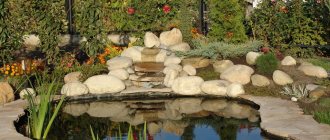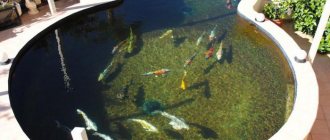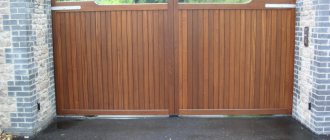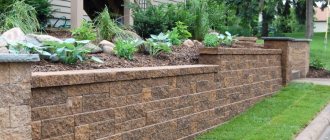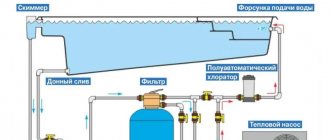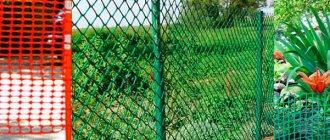To decorate the site, summer residents not only decorate flower beds, plant trees, build gazebos, but also equip artificial reservoirs, ponds, and swimming pools. Choosing a location and design is not the most difficult thing in the process of their construction. Waterproofing technology requires special attention. You can do without it - it is necessary to carry out mechanical cleaning of the bottom of the dacha lake. It will not be possible to achieve constant cleanliness in a reservoir. To solve the problem, the bottom is covered with a waterproofing film for the pond. It remains to understand how to choose high-quality and at the same time budget material.
Why is it better to use film?
Most likely, few people will want to dispute the fact that a pond is the most beautiful decoration of a summer cottage. Therefore, it is very important that those who decide to build such a building find answers to all the questions that arise during the construction process. The quality and durability of the pond depends on this.
Pond in the country - how to make it yourself
Caring for a pond is not easy. Therefore, it is very important that the waterproofing is at a high level. After all, it is reliable waterproofing that ensures high-quality and durable operation of the structure. Garden pond liner is the best insulating material for ponds. We will now consider its features.
Purpose of film for a garden pond
The main purpose of a film for a pond is waterproofing. It holds water in the pit, preventing it from penetrating into the ground. This is a kind of membrane partition that holds liquid within the required boundaries.
You can use other options for constructing an artificial reservoir, for example, a concrete base. But such work will be more labor-intensive. In addition, you need to think about how to clean it in advance. That is why many owners choose to use the optimal technology - constructing a pond with a film bottom.
Before choosing a film as insulation for a reservoir, you need to determine what the benefits of its use are. And it is as follows:
- rotting of the material is excluded;
- the film can be used on any soil and on different bases;
- at any time, with minimal effort, you can reorganize the reservoir;
- it is possible to choose a different coating pattern that will increase the attractiveness of the artificial pond on the site.
And most importantly, all work on laying the film can be done with your own hands. This does not require any special skills
The main thing is to choose the right coating according to the technical characteristics.
Photo: sotka.guru Using film you can create any outline of a pond, including the most complex
Advantages of film for artificial reservoirs
Pond care is not a simple technical process. A good insulating coating can save you a lot of hassle. What kind of quality coating is it for swimming pools, ponds, reservoirs and artificial lakes?
Film laying
Modern manufacturers of insulation materials have invented a reliable waterproofing material that has a lot of advantages:
- An environmentally friendly product, which means that it will not harm the environment or people;
- Reasonable price;
- Large selection of colors and patterns;
- Significant resistance to mechanical and chemical damage;
- High quality material can last up to 50 years;
- Easy and convenient to use when decorating an artificial pond.
Agree that these listed advantages are enough to pay attention to such a material as film insulator. Among owners of suburban areas and landscape designers, pond film has become widely known. This material is not at all difficult to work with .
Naturalness comes first
Any body of water begins with a pit. Then a purchased polymer solid bowl is installed or a concrete one is poured. The polymer bowl has its pros and cons. Among the disadvantages, we will primarily mention the tendency to damage and the stamped shape. Therefore, if you have the physical and material opportunity, give preference to a concrete pond. This is a more durable material, and a concrete bowl provides more opportunities for further decorative transformation of the reservoir.
Film covering with concrete filling of the pond
To prevent concrete from crumbling due to exposure to moisture over time, it is lined with tiles, glass mosaics or even marble. But, if we are talking about an artificial pond, then it will only lose from this. Ponds in the garden are erected with the goal of getting closer to nature, and not to emphasize the man-made nature of the design.
Therefore, the relatively new method of film waterproofing helps to cope with this problem. The coating will be smooth, but at the same time will not emphasize the unnaturalness of the reservoir.
Film coating can be divided into three types:
- Ultra-thin coating is a film up to 1 mm;
- Ultra-durable coating is a film of 1.5 mm and above;
- Having air bags - a durable coating with air cushions that prevent injuries when falling.
These films are commercially available in both black and all sorts of bright colors. Just look at the names: Blue Lagoon, Golden Sand, White Pearl.
How to apply the composition yourself
Most manufacturers indicate that priming the surface is not required before starting work, and this reduces the cost. The material is applied directly to the concrete with a hard, wide brush, roller or spatula.
Execution steps:
- Clean the concrete base from dust, mortar and other contaminants. Level existing cracks with mortar. Treat the entire surface with liquid rubber in several layers, leaving no empty spaces.
Surface treatment with a wide brush
To obtain a thickness of 3 mm, the estimated material consumption will be 4 kg/1 sq. m.
After a day, the reservoir needs to be filled with water. It is difficult to deform a frozen membrane, but if this happens, the composition can be easily applied locally in the same way. The material is non-toxic, but it is recommended to carry out all activities wearing a respirator and closed clothing.
Types and characteristics of film for artificial ponds
The modern landscape design market offers us the following waterproofing options: polyethylene film, PVC material (polyvinyl chloride) and butyl rubber pond film.
PVC film
Polyethylene film is the most inexpensive material of this kind, but at the same time the most fragile (the warranty is only 2-3 years).
PVC film is a very durable material that has high elasticity and waterproofing
Technical characteristics of PVC film:
- Weight of one m2 from 0.5 kg to 1 kg;
- Thickness 0.5-1.2mm;
- Elasticity index 200%;
- To break the integrity of the polyvinyl chloride film coating, mechanical action from sharp glass or metal is required.
Installation of PVC film on a small pond (video)
Butyl rubber film
Butyl rubber film is a durable and reliable material that will serve you for a long time (up to 50 years). A favorite material for builders because it is easy to work with. Also, such material is not subject to destruction from sunlight (cracks do not form) and temperatures (this is very convenient, because you do not need to drain water from the pond for the winter). Safe for the aquatic environment (compatible with fauna and flora). Another advantage is that this film is black, and this helps create the appearance of a deep bottom in the finished version of the pond.
Butyl rubber film
Technical characteristics of rubber film:
- The weight of one m2 is approximately 1.5 kg;
- Thickness 1.02mm;
- Elasticity index 300%;
- To break the integrity of the butyl rubber film coating, mechanical action from wood or metal is required.
If, nevertheless, you were able to cut or somehow damage the film, then using rubber mastic you can repair any hole (such as a repair kit).
Rolls of rubber film are produced in fairly large widths (3-15 meters), which allows for a complete, seamless coating of small ponds.
Installing rubber film is just as easy as installing PVC film. True, due to the fact that rubber rolls are much heavier, you need at least one or two more pairs of hands. The pieces of film are glued together with tape. The places of such soldering remain waterproof.
Flexible butyl rubber material will follow any shape and outline of the pond. And the folds will disappear behind water, stones and plants. Experts advise using a geosubstrate to protect the rubber film from the effects of rhizomes.
Tips for choosing film
You can't do it without helpers!
It can be seen that there are now plenty of materials for covering swimming pools and artificial reservoirs. Therefore, it is very important to make the right choice. We hope these criteria will help you:
- Size and depth of the pond. If the depth of the reservoir is less than a meter, then a plastic film 0.5 mm thick will be sufficient; if the depth is up to 2 meters, then you need PVC film 1mm thick; if your pond is more than two meters deep and wide enough, then use butyl rubber film to cover it;
- Your choice should also be dictated by what you plan to place in the pond (additional objects - water cascades, a waterfall, a fountain, fish, or if you plan to swim in the pond).
Selection rules
When choosing a film for arranging a pond, you need to take into account not only the decorative features of the material
It is equally important to correctly calculate the waterproofing consumption and take into account some of its operational features
When calculating material consumption, it is necessary to include some reserve. In general, the following formulas should be used:
- film length = pond length + 2 depths + allowances of 30-50 cm on each side;
- film width = reservoir width + 2 depths + allowances of 30-50 cm on each side.
As for performance characteristics, the most important criterion influencing the selection of film thickness is the conditions in which the reservoir will be used. Here the following factors must be taken into account:
- the more uneven and bumpy the bottom is, the thicker the film base should be;
- when the depth of an artificial reservoir is less than 1 m, a film 0.5 mm thick will be sufficient;
- for reservoirs with a depth of 1-2 m, it is better to take the material in a layer of 1 mm;
- for artificial reservoirs with a depth of more than 2 meters, preference should be given to butyl rubber film.
The choice of base material can also be influenced by the complexity of the shape of the garden pond, the presence of elevation changes, and the presence of waterfalls and fountains. In addition, you need to think in advance whether the pond will be used for breeding live fish or swimming.
Manufacturers of materials and price review
Like many other products, film for artificial ponds is divided into elite and general products. For example, an elite film is one that imitates natural materials (stone, gravel). The price of such a film will start from 700 rubles/m2. The Italians occupy the leading position. German firms are following them and US manufacturers are competing with them.
There are a lot of film manufacturers, so proceed from your requirements for the pond.
We bring to your attention an overview of the most famous manufacturers of pool covers:
- Agrilac is an Italian company specializing in the production and sale of PVC material. The products of this company are of the highest quality and affordable. Agrilac film is the best option. Product prices start from 150 rubles/m2;
- IZOFOL is a Polish manufacturer specializing in the production of waterproofing films. The most important principle of the company is product quality, so the films of this company are not inferior to the market. The price starts from 200 rub/m2;
- WTB ELBEsecur is the most renowned manufacturer of waterproofing materials on the German market. Produces and distributes several types of PVC material. The strength of the offered product more than compensates for the small assortment. The films of this company can even withstand heavy loads. The price starts from 230 rub/m2;
- RENOLIT is another world-famous German company. The products are of high quality and a wide range. The price starts from 200 rub/m2;
- Gardena is a European association engaged in the production of items for landscape design. The price starts from 200 rub/m2;
- Heissner is a German brand whose specialty is the chemical industry. Therefore, they are quite well versed in the production of PVC films.
There are not many manufacturers of butyl rubber film on the market, because the production of such material is quite complex and expensive:
- EPDM PondLiner is the leader of such products on the US market and in the world too. Trade is carried out with more than 100 countries. The price starts from 270 rub/m2;
- Larex is an Italian company. To make the price more affordable, they reduced the thickness of the membrane film. The price starts from 160 rub/m2;
- Ergis is a Polish brand that has tried to find a price/quality ratio that is beneficial for everyone. Decent company. The price starts from 200 rub/m2;
- OASE and Pontec are German manufacturers of butyl rubber film. The products can be classified as elite. Therefore, the price starts from 300 rubles/m2.
It is clear that the list of manufacturers is not complete, but these listed are of the highest level.
Step-by-step installation of pond film (video)
Your choice - butyl rubber film or PVC coating - should be influenced by a qualitative analysis of your reservoir. Consider the size and purpose of your pond. Butyl rubber film material does not react with chemicals intended for pool care, and is also not damaged during water filtration. To avoid re-ordering, calculate the required amount of material. Also be careful that you are provided with guarantees for service, certificates, adherence to all manufacturer requirements, and the possibility of exchange.
Nowadays, the landscape design market is very competitive, so choose the material for pool protection that meets your needs. Gone are the days when cracks were covered with clay. Polymers that have replaced natural materials of nature sufficiently meet all the necessary requirements for high-quality waterproofing.
How to build a decorative pond from film with your own hands
Anyone can build a pond with their own hands; there is nothing complicated about it. The main thing is to correctly calculate the parameters of the film and carefully carry out all stages of the work. If you plan to build a large pond, you will need to connect two or more parts of the covering. You can do this in one of the following ways:
- double-sided adhesive tape;
- assembly adhesive composition based on neoprene;
- adhesive composition for PVC intended for reservoirs;
- glue-sealant for PVC film;
- with a regular iron or film welding machine.
Photo: vse-postroim-sami.ru Film coating gluing technology
Tools and materials
To build a pond you need to prepare:
- film, dimensions can be calculated using the formula;
- sand;
- gravel;
- wood cuts for decoration;
- plants in pots;
- shovel and chainsaw.
Photo: 7dach.ru Marking can be done with a regular hose
Step-by-step instructions for making a pond with your own hands
Let us consider all the stages of construction and decorative design of the banks of a small pond in more detail.
| Illustration | Description of action |
| Dig a two-level pond. The contour can be pre-marked with a watering hose. You need to start work from the top line. The bottom is formed last. Compact the banks with a shovel, and add a cushion of sand 5-10 cm thick to the bottom. Lay 2 layers of film. To avoid tearing it, it is better to take off your shoes. The covering should lie freely, without tension. When filled with water, it will take the desired shape. | |
| Press the film against the banks with stones. Fill the pond with water and leave it for a day to check the tightness. | |
| To create higher banks, add sand to a small bank. | |
| Compact the sand with your hands and cover the shaft with film. Trim off excess edges of the film. | |
| Dig a small groove near the banks, tuck the film into it and cover it with earth. Saw the tree into small sections up to 10 cm thick. | |
| Decorate the coastline with saw cuts. Rinse the gravel and pour it onto the bottom of the reservoir. | |
| Decorate the banks with plants. The pond is ready. |
To create such a decorative pond, only 250 rubles and 2 days of work were spent. Additionally, it was possible to lay a layer of geotextile between the sand and the film to prevent vegetation from tearing the coating. Accordingly, the cost of work will increase slightly.
You can watch all the steps in more detail in the video:
Watch this video on YouTube
Watch this video on YouTube
PVC film
The main advantage of this film is its high resistance to bioaggression, as well as its environmental friendliness. It has high tensile strength, is elastic, and also has an excellent coefficient of friction, which greatly facilitates its installation on the bottom, as well as on coastal slopes. The material is completely sealed, having a two-layer membrane and high density. It is resistant to frost, the root system does not have any effect on it, chemical resistance is also quite high.
Among the disadvantages, it is worth mentioning its fragility (service life no more than 10 years), as well as a fairly high level of humidity when interacting with soils.
Return to content
Waterproofing with rubber
You can replace the film with EPDM rubber. This is a special butyl rubber, which is based on an ethylene copolymer and a diene monomer. The material is even more elastic and is not afraid of frost. And its durability is very high. In addition, it is completely environmentally neutral.
But most often, for self-application, they take liquid pond rubber. Bitumen, reinforced with polymer components, creates a durable and elastic surface. Water-based mastic can be quickly and efficiently applied to the walls of the pit using special equipment. But in this case you will have to use the services of a master.
Typically, the composition is distributed onto geotextiles fixed in the pit using a roller. The first layer is applied 4 mm thick. It takes up to two hours to harden. Then you can repeat the operation until the thickness is created, according to the calculations.
The advantage of this method is not only its cheapness and ease of implementation. Using this material you can cover a surface with any fancy curves. And if you first create a certain bottom relief, the rubber will completely repeat its shape. All that remains is to paint the surface in the desired color.
Waterproofing with clay
The material for waterproofing a pond can be supplied by nature itself. Before the advent of modern technologies, the bottom of an artificial pool was strengthened exclusively with clay. But this old-fashioned method presupposes deep knowledge. It will be necessary to analyze the composition of the soil in detail, as well as constantly monitor and maintain the specified water level.
The entire waterproofing process comes down to creating a layer cake:
- The bottom of the pit is covered with soot or wood ash.
- The first layer of clay is applied, mixed with clean water to a paste-like state. Natural material should not have organic, sandy or solid inclusions.
- The mixture is well compacted so that the layer thickness is from 10 to 15 cm.
- The next layer, already 30 cm thick, is applied to the dried but unhardened layer.
- The bottom is filled with small crushed stone, in gradations of no more than 4 cm.
- Sand is poured on top.
Perhaps the old-fashioned method will save money. But you need to be prepared that the water in such a pond will gradually oxidize and lose oxygen. And essentially slowly turning into a swamp. Therefore, this option is most suitable for creating shallow water abundantly overgrown with certain varieties of plants.
Waterproofing a pond pit with clay Source qlumba.com
